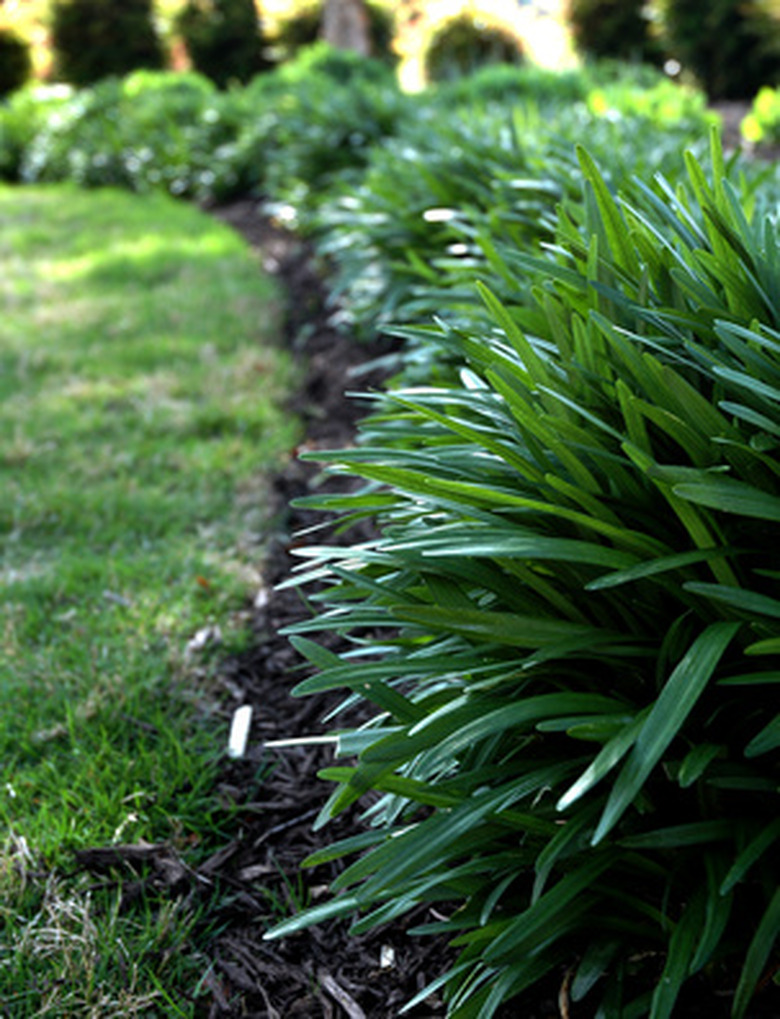Ornamental Spider Grass
One of a host of common names for ornamental clumping perennials belonging to the botanical genus Liriope, spider grass is also commonly called monkey grass, border grass, Aztec grass, lily turf and liriope. A popular ground cover or edging plant, liriope with longer, arching grass-like leaves are often dubbed spider grass, especially in the Midwest. Two species of liriope are grown in gardens: Liriope muscari and Liriope spicata, best across U.S. Department of Agriculture hardiness zones 6 through 10.
Origins
Ornamental spider grass is native to eastern Asia. These species of Liriope typically grow naturally in the moist, acidic woodlands of northern Vietnam across China, Korea and Japan, according to "A-Z Encyclopedia of Garden Plants."
Features
Thin, narrow leaves that look grass-like emanate from rhizome roots in spider grasses. The leaves usually arch gracefully, mimicking the look of long spider legs in a basal clumping plant. In late summer, upright stems with small but finger-like clusters of lavender to purple flowers are seen, followed by tiny blackish fruits that linger into early winter. In winter the leaves remain evergreen as long as temperatures do not drop below or remain under 10 F.
- One of a host of common names for ornamental clumping perennials belonging to the botanical genus Liriope, spider grass is also commonly called monkey grass, border grass, Aztec grass, lily turf and liriope.
- A popular ground cover or edging plant, liriope with longer, arching grass-like leaves are often dubbed spider grass, especially in the Midwest.
Growing Requirements
For best growth, plant ornamental spider grass in a moist, well-drained soil that is acidic (pH below 7.0). Tolerant of drought and dense shade, these plants will grow lusher and faster in evenly moist conditions with at least four to six hours of direct sunlight daily. Plants also perform well in full sun exposures, too. Avoid dry, sandy soils that lack access to irrigation or any type of soil that is soggy.
Uses
When planted with a spacing of 8 to 12 inches apart, spider grass grows into a dense, soft-textured ground cover that is a viable tall-growing substitute for turf grass, according to Dr. Allan Armitage, herbaceous plant expert from the University of Georgia. Or, solitary clumps make accents in a mixed perennial border or foundation bed. Linear plantings make attractive edging along lawn edges or other planting areas in the landscape.
- For best growth, plant ornamental spider grass in a moist, well-drained soil that is acidic (pH below 7.0).
Maintenance Tips
When the foliage of spider grass gets browned by frosts or drought, the plants are cut back to remove tissues and facilitate an attractive rejuvenation. Armitage and Georgia gardener Walter Reeves recommend cutting back the plants with a lawn mower or pruners to a height of 2 to 3 inches in mid-spring before the new leaves naturally appear. An application of fresh compost or granular slow-release fertilizer (such as 10-10-10) immediately after the clipping promotes healthy and attractive growth the rest of the growing season.
References
- "A-Z Encyclopedia of Garden Plants"; Christopher Brickell and H. Marc Cathey, eds.; 2004
- "Herbaceous Perennial Plants"; Allan M. Armitage; 1989
- Walter Reeves The Georgia Gardener: Liriope
- Clemson Cooperative Extension: Liriope
